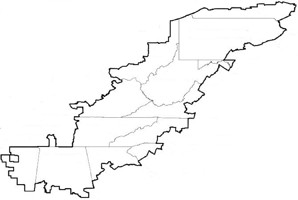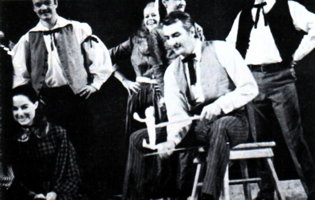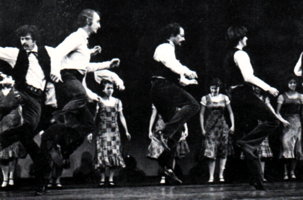
|
The Society of Folk Dance Historians (SFDH)
Styles of Appalachian Clog Dance
[
Home |
About |
Encyclopedia | CLICK AN IMAGE TO ENLARGE |

|
 Research into the exact history of the fascinating dance form of Clog dancing is not yet complete. Nevertheless, geographical differences in style and historical accounts of migrations and the social events of the southeastern United States lead to some conclusive evidence.
Research into the exact history of the fascinating dance form of Clog dancing is not yet complete. Nevertheless, geographical differences in style and historical accounts of migrations and the social events of the southeastern United States lead to some conclusive evidence.
A mountain range just about divides the Virginias and the Carolinas from Kentucky and Tennessee and cuts across the northern part of Alabama and Georgia. Even though dance styles vary throughout the region, the most significant differences seem to be on opposite sides of the mountain range. The general trend of the same basic dance form – the Appalachian Square – is danced lightly and high on the foot on the western side and falt-footed and low on the eastern side where Clogging seems to have evolved to its present form and style.
English, Irish, and Scottish people were the predominate settlers in the Appalachian region, with a large inflow of Blacks settled on the plantations which were more heavily concentrated on the eastern side of the mountains. German< and French settlers were fewer and later but their influence was significant.
APPALACHIAN SQUARE
The Appalachian Square, the figures of which are usually called by one of the dancers, begins with a circle of couples (traditionally eight, but now with any number) which, after executing a few figures, breaks into sets of two couples each. One couple in each set moves to the next set between small set figures at the whim of the caller. The dance eventually goes back to one big circle and soon ends.
On both sides of the mountains, the Appalachian Square is done without the fancy footwork known as "Clogging," but on the eastern side it is called Smooth Dancing without the clog step and Big Circle Mountain Dancing or Clogging when the footwork is included. On the western side, Clogging has not been popular until recently. Many leaders and dancers have never even seen it.
KENTUCKY RUNNING SET
This is the same area that is known for the Kentucky Running Set which is different than the Appalachian Square but often confused with it. The Running Set is a couple circle dance done with an old English-style long gliding running step (also, more recently, a double-time running step) which stops at a given point so that a lead couple can "visit" each of the four to seven other couples to do a figure, and then travel on to the next couple. All other couples stand and wait their turn. Traditionally, the figures of this dance were set to certain musical phrases, but now it is more often done with a caller.
Some of the men, while waiting their turn to do a figure with the lead couple, will break into a jig-like step in place called a "Hoedown," but this is not widespread. Actually, the Running Set itself is rare these days. The few leaders and participants this writer located relied heavily on Cecil Sharp's description, a misunderstanding of which is believed to have led to the double-time running step. (Cecil Sharp is the English researcher who discovered the Kentucky Running Set in the early 1900s and apparently mistakenly identified it as an ancient English dance.)
SOLO DANCES
Further south in Tennessee and northern Alabama where the Running Set is practically unknown, but where play-party games and the Appalachian Square (without the "clog" steps) are popular, a type of solo step dance is found that is similar to the Irish "Slip Jig" (or "Seven and Threes"). The participant (usually a man) stands tall, uses his arms very little, and dances on the balls of his feet. (A type of Clog with this look was reported in up-state New York in the early 1900s and more recently in Ohio. A flat-footed dance with the same upright body position is done in parts of Virginia called Sure-Footing.) This author calls the Tennessee variety Cumberland Jig. The Westchester Lariats of the Los Angeles area perform a "jig"-type step (a bouncy "two-step") at a fast pace – almost as fast as the "Kentucky Running Step" – from Director J. Tillman Hall's home town in eastern Tennessee. It appears to be Irish in style.
JIG DANCE
Across the Mississippi River in Arkansas a Jig Dance (so called by the residents) is done which is executed high on the balls of the feet, but without the rigidity of the upper body that is seen in the Cumberland Jig style and the Sure-Footing style of Virginia. The key factor in the Arkansas style is that – just like the competition or precision Clog dance of northern Georgia – it is a three-count step done to either 2/4 or, occasionally, 4/4 music.
For example, the basic step is left, right, ball of left, right – counted 1, 2, &,3 (slow, slow, quick,slow or S, S, Q,S) musical counts of either 1, 2; 1, 2; or 1, 2, 3, 4. The step counted across the music would be: 1, 2, &;1; 2, 1, &,2; to 2/4 music; or 1, 2, &,3; 4, 1, &,2; etc. to 4/4 music. Apparently these are the two predominate geographical areas for this particular rhythm.
In Arkansas, the dance is either a solo or in old-time Square Dance figures where one couple visits all the other couples in the set to execute figures one at a time. In the precision Clog, figures range from the older Grand March type to variations of modern Square Dance figures. (One precision team leader confessed in the summer of 1976 that he got some of his figures out of a Danish folk dance book from the local library.)
POLKA-TYPE SOLO DANCES
The Missouri Stomp, the St. Louis Hoedown, and the East Texas Breakdown are executed in a different style than any of the solo dances mentioned above and are all apparently related to the polka of northern Mexico.
The Missouri version is a heavy step with one foot followed by a stamp of the other heel on the musical upbeat (count 1, &).
The St. Louis version is the same as the Missouri version except that it is preceded by a step, ball of the other foot, step (step, ball, change), executed in two counts. The sequence is step, ball, step, stamp (no weight on the stamp). The musical counts are 1, &,2, &.
Included in the East Texas Breakdown are the above two sequences, but the style is characterized by knee-slapping in between continual stamps of the same heel while chugging slightly forward on the standing leg.
These three styles of dance steps appear to be Bavarian in origin and can safely be assumed to be so. Residents of the area give credit to Bohemians who settled along the Mississippi and in northern Mexico.
BLACKS AND BUCK DANCE
 An area, including Mississippi, Alabama, and southern Georgia, is the home of the Buck Dance, a traditional Black's solo dance. Executed flat-footed, similar to the North Carolina clog, the main emphasis in Buck Dance is a backward chug. The step sequence includes a heavy step followed by a chug backward on the same foot. The body is usually bent forward, and in one version, known as the Buzzard's Lope, the arms appear to flap like wings.
An area, including Mississippi, Alabama, and southern Georgia, is the home of the Buck Dance, a traditional Black's solo dance. Executed flat-footed, similar to the North Carolina clog, the main emphasis in Buck Dance is a backward chug. The step sequence includes a heavy step followed by a chug backward on the same foot. The body is usually bent forward, and in one version, known as the Buzzard's Lope, the arms appear to flap like wings.
Buck Dance differs from the North Carolina Clog in that it does not emphasize toe shuffles and the body is held more upright. The term "buck dance" has evolved in recent years to mean any kind of solo dance done by either Whites or Blacks.
There are many references to buck dance contests on the plantations. Blacks learned the squared dances that were done in the main plantation house and apparently added the chug, shuffle, and body movements typical of dances of African origin. Descriptions of plantation black Square Dances sound much like a description of what we now know as Big Circle Clog Dance as seen in western North Carolina.
Blacks and Whites both added embellishment steps to dances such as the Virginia Reel and other Contra dances. Whites added English- and Irish-type steps that emphasize an up-and-down motion as in hopping and skipping. Blacks style is a downward thrust of the body on each step.
The Blacks' Square Dance, with many variations, was performed in minstrel shows and later the steps were done in vaudeville. Influenced by the Irish Jig and the English Clog, this style developed into Tap dance, the Charleston, and other forms of popular dance. At first look, it doesn't seem that the Charleston and the Clog could have a common origin, but the relationship is clear when the forerunner of both is considered – the Ring Shout (a Black religious dance) and Buck Dance. A dance similar to the Charleston is currently popular among whites in the West Virginia Hills, called Flat-Footing.
Blacks often called the dances and fiddled the tunes for the plantation owner's parties. Occasionally, the owners and their guests would join in with the Blacks' foot-shuffling square dances. Even after the slaves were freed, blacks were hired to call and play for the dances of Whites. (And the price hasn't gone up much either. Some were paid twenty-five dollars a night 100 years ago.) Dances with the chugs and shuffles were still found among Blacks of the Georgia Sea Islands and among tribes in eastern Africa.
One dance in particular collected from Youruba, Africa, and exhibited to a class at the University of California, Los Angeles (UCLA) by a Yale professor, resembles the Charleston and, even more closely, Flat-Footing as done in West Virginia. Add the arm embellishments of the old Buck and Wing and it looks like a dance said to be from Africa, and done by southern Blacks, called the Buzzard's Lope. Fancy footwork was added to this dance in America but it is still done without chugs or shuffles on the Georgia Sea Islands.
PRECISION CLOGGING
 In southern North Carolina and northern Georgia, clogging takes on the flavor of a performance more than a recreation. This is the style already mentioned as competition or precision clogging. The figures used are the same as in the Appalachian Square with the addition of figures from other sources.
In southern North Carolina and northern Georgia, clogging takes on the flavor of a performance more than a recreation. This is the style already mentioned as competition or precision clogging. The figures used are the same as in the Appalachian Square with the addition of figures from other sources.
Precision/competition dance teams appear more trained and execute the step sequences in unison. Big Circle Clog dance teams and groups seem more relaxed and use individual variations of the step sequences.
The step sequence in both of these styles begins with a double-toe tap. It looks more like a double-toe bounce than a brush because the foot usually moves neither forward nor backward. Immediately following the double-toe is a step on the same foot in the same spot. This double-toe is predominant only in these two styles of group Clog dance and in one style of solo dance – the Blue Ridge Clog step from Virginia which has a double-heel tap on the opposite foot.
In the eastern part of Virginia these are two distinct styles of clogging. One, sometimes called Sure-Footing, is practically the same as North Carolina style except for the lack of the double-toe tap. Instead, the stepping appears a bit faster and with more up-and-down motion of the body. The other Virginia style (both styles are simply called Clogging by most participants) utilizes a brush-through with the whole foot that gives the appearance of kicking something across the floor. The upper body is bent forward and the step sequences are always in unison.
OF CHEROKEE ORIGIN?
Clog is an English word not usually found in books about Black dance. At one time, it referred to a Clock dance in England. However, most people related the name of the dance to the type of wooden-sole shoe of the same name. The English Clog has a foot flap similar to the double-toe or shuffle, but there is no chug. The Irish and Scottish Jig steps are executed with a skip on the ball of the foot. Bavarian dances utilize heavy stamps and heel taps while African dance is characterized by upper body movement combined with foot shuffles and chugs.
Publicity for the Asheville, North Carolina, Clog and Smooth Dance Festival held every summer says that the Clog was influenced by the Cherokees. Of course, this is possible, but Cherokee dancing is distinguished by easy bounces through the ankle and knee, not at all in the manner of any of the Clog dance styles.
It seems that the popular Appalachian Clog dance has been influenced by may styles of dance. In some areas, it has been obviously influenced more by one than another, but most of the Appalachian Clog styles are unique and cannot be traced to a single origin.
DOCUMENTS
- Appalachia, a region.
- Appalachian Dance and Music, an article.
- Buck and Big Circle Dances of Appalachia, a region.
- Clogging Glossary, an article.
- Folk Dancing in the South, an article.
- Jerry Helt, an article.
Used with permission of the author.
Reprinted from "Styles of Appalachian Clog Dance"
in Viltis Magazine, January-February 1978, Volume 36, Number 5,
V. F. Beliajus, Editor.
This page © 2018 by Ron Houston.
Please do not copy any part of this page without including this copyright notice.
Please do not copy small portions out of context.
Please do not copy large portions without permission from Ron Houston.